Should You Join the Park Slope Food Co-Op?
Should you join the Park Slope Food Co-Op? Verdict: “It’s worth it despite the crowds, the assholes, and the soviet-style politics.”
Yes, The World Toe Wrestling Championship
Oh, Britain: “Based on the better-known sport of arm wrestling, toe wrestling sees competitors use their feet and toes to overpower their opponent. The sport was invented in 1976 when regulars at a Derbyshire pub set about searching for a game that the British could win. A decision was made to invent a new one. Locals in Wetton — where the game was born — have been dominating the sport ever since. This year an epic battle between arch rivals ‘Predatoe’ and ‘Nasty Nash’ dominated proceedings.”
[Previously in Knifecrime Island championship pursuits: shin-kicking and face-making]
"Beauty Transformation," Stockholm Syndrome and Womens' Magazines
“Not long after working at Allure, I had perfectly straight hair with the most expensive caramel highlights, skin that glowed and perfectly white teeth. And every other day, I had on a pair of Stuart Weitzman or Dolce&Gabbana; heels that I tried my hardest not to topple over in while walking on the too-slippery floor of the infamous Frank Gehry-designed cafeteria…. It took me about two years to realize that the whole thing was bullshit.”
— Lady escapes lady mag.
Male Muses And Inner Dicks: A Conversation With Kate Christensen
Male Muses And Inner Dicks: A Conversation With Kate Christensen
by Maud Newton
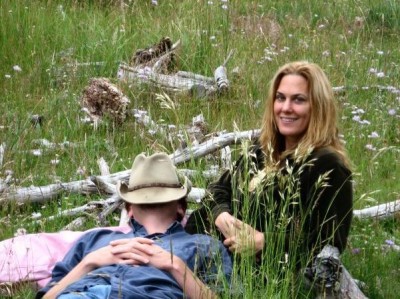
I discovered Kate Christensen’s work several years ago, when I read The Great Man, and then all the rest of her books, in one weekend. After I praised them on the radio, she emailed me and we became friends, which is great because she’s a wonderful, smart, funny, generous person, but it’s also weird, because she’s one of my favorite living writers, and here she is, flesh and blood, moving through the world like the rest of us.
Her latest novel, The Astral, is about poet and sometime lothario Harry Quirk, 57, whose wife has just destroyed all the sonnets he’s been working on for years and, wrongly accusing him of having an affair with a friend of theirs, kicked him out of their Greenpoint (Brooklyn) apartment. He’s moved a few blocks away, into one of the city’s most notorious SROs.
You’ve said that you wrote your first novel in the eighth grade for a boy you liked. “He giggled gratifyingly at each chapter,” you told The New York Times, “which I found so inspiring, I have been collecting male muses ever since.”
If Robert Graves were still around, he’d say that’s impossible: “Woman is not a poet: she is either muse or she is nothing.” Don’t worry, though! It’s not that women — sorry, woman — can’t write, just that when a woman writes “she is herself the Muse, a Goddess without an external power to guide or comfort her.” Why do you think there’s been so much resistance historically to the idea that a woman might be creatively inspired by love and lust and longing for a man?
This makes no sense to me at all. Women need men to get pregnant, among other important things. So why can’t we need men to fuel our work?
My first muse was a chubby, bespectacled, brown-eyed, sharply intelligent 13-year-old boy in Phoenix, Arizona in 1975. When he laughed at and loved my writing, I felt the erotic surge of my own power. Since then, I’ve written for and about and to and because of men.
Writing with this “external power to guide and comfort me” has inspired me to write in first-person male voices — it’s inspired my sex scenes — and it’s caused me to work very, very hard, in a disciplined, sustained way, as if I were a man, as if I were entitled to seize all that time for something as dubious as novel-writing. My male muses are crucial to my work, inseparable from it. They’re the oil that lights the lamp.
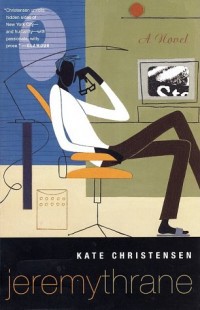
Last month, in (what I like to call) your “dick for a day” essay, you explained that you ended up writing from a male point of view partly as a reaction to critics’ dismissing your first book, In the Drink, as chick lit: “My second novel, Jeremy Thrane, is narrated by a man who, in the opening passages of the novel, describes his penis, in case anyone is in any doubt as to his sex.” Did you sit down and write those paragraphs in a white-hot rage? “Oh, yeah, well here’s my dick, you motherfuckers!”
Ten years ago, that might have been the case. In fact, I wrote that essay in a state of calm, retrospective honesty; the entire thing emerged in a couple of hours, pretty much exactly as it was published. It felt very, very good to write it, the way it always feels to tell the plain truth without worrying what people will think.
At the end of the essay, I explain that I’ve relinquished my “inner dick,” at least for now. I spent my late twenties and early thirties in a state of hotheaded fury — at the way things were, at the unfairness of it all, at the wrongheadedness of my species — you name it. I think that, over the years, this white-hot, male-feeling rage has mutated into another, different, possibly purely female mode, one that will likely inform my next books — but I can’t know until I’ve written them.
Oh, I was unclear! I love that essay, as you know, but I meant: did you write the opening of Jeremy Thrane in a rage? It amuses me to imagine you sitting down to write your second book and starting things off by, so to speak, slapping your narrator’s cock on the table.
Anyway, enough dick talk. Getting back to muses: Do you think there’s any more misguided impulse for getting involved with a writer — or, really, any kind of artist, but particularly a writer — than that you want to see yourself glorified and sanctified and memorialized in the writing? Does that ever end well?
Can it possibly end well? First of all, writers are difficult to live with, and the possibility of being immortalized or celebrated in our work is unlikely if you’re the person we see every day over the dirty breakfast dishes. The payoff for musedom is slight enough (as I see it) to be nonexistent; you have no control over whether you’re portrayed at all, let alone in what light, and, worse, you have to live with a moody, insecure, egomaniacal workaholic without a secure income or any benefits. When it’s a woman, throw in PMS, and any gambler could tell you the odds against that horse.
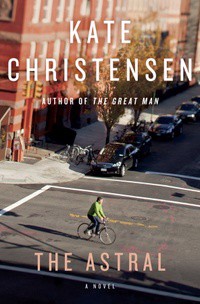
Luz, the rageful wife in The Astral, who has destroyed Harry’s poems and kicked him out, pretty clearly married him expecting to serve as his muse. Through the years, as his writerly star rose and then fell, she seems to have consoled herself with the idea that she was his subject — which may be why, at least as Harry tells it, she so utterly flips out when she discovers that the sonnets he’s been working on for so long are about other women. He tries to explain that the poems’ subjects are imaginary women, idealized women, women who, existing only in his mind, are no threat to their marriage, but she continues to insist that he’s having an affair.
It’s fascinating to me that Harry suspects their marriage would have been easier to repair if he had been physically unfaithful. It’s the betrayal of his imagination that Luz seems to find unforgivable. Or at least she resents these poems more than the affair he actually did have twelve years before. Have you ever been involved with someone so hell-bent on being your muse that he (or she) gauged your fidelity by what you wrote?
Never. Unlike Harry, I have no tolerance for being controlled by sexual jealousy or by anything else. I created Luz out of my own extreme distaste for, and desire to expose in writing, whatever that mechanism is in certain women that causes them to spy without permission on their lovers’ or husbands’ emails or texts or conversations (or poetry) to gauge whether or not they’re being unfaithful, and then to interrogate them obsessively and rip them to shreds and declare vengeance on the so-called “other woman” and throw things and stamp around screaming.
There is something in that loony, pathetic, deranged behavior — most of all a delusional sense of entitled ownership of another person, but also a grasping, desperately insecure possessiveness — that makes me cringe. Luz’s character is based on the wives and girlfriends of men I’ve known. I’ve never behaved that way, and I’ve never been in a relationship with a man who behaved that way. (It wouldn’t last long, to put it mildly.) But it was lots of fun to write about.
I once dated a guy who was a little bit like Luz; it didn’t go well, to say the very least.
In an essay about marital boundaries, you remembered all the flirting and longing and intense email exchanges that preceded your divorce. Do you think Harry was in a similar state, that his marriage to Luz was emotionally over for him and needed to end and that she ultimately did him a favor by booting him?
I envision Harry as very, very lonely in his marriage, but dependent on it and committed to it — an all-too-common state of affairs, in my experience. Before Luz booted him out, he was paralyzed and stuck and stunted in a marriage that was emotionally defunct, passionless. When the book opens, he’s floundering toward something else, some other way of being that involves growing a spine and a set of balls, as it were. I think Luz did him an enormous favor by booting him out, but as for the rest of it — the accusations, the destruction of his work, the victimized role she played… the marriage should have ended on its own terms, without all that psychodrama, without the histrionics. In that essay, I say in so many words that it’s better to leave cleanly than to stick around and make trouble; in the case of Harry and Luz’s marriage, it would have been better for Harry, of course, if she’d just quietly asked for a divorce. But then there would have been no novel.
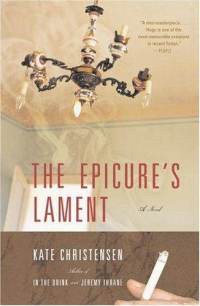
In an interview about adapting your third novel, The Epicure’s Lament, you talked about your changing feelings toward the narrator, Hugo. “Now that I’m so much older than he is, I see him as young and confused,” you said. “At the time, I accepted his self-view of himself as a bitter old washed-up failure; now I understand how mistaken he is in his self-conception. He’s only 40. He has no idea how young he really is and how much possibility there is left in a life for change.”
How about Harry? At the start of The Astral, he’s broke and jobless and, having lost his teaching gig and then sat around writing for years while Luz supported him, basically unemployable. Like Claudia (of In the Drink) and Jeremy (of Jeremy Thrane), he’s careening around, casting about, getting himself into trouble…
I do seem to love these characters. Maybe floundering is my novelistic subject, if I have one. Lives in flux and trouble, characters challenged to face certain hard-to-face things, interest me as a dramatic prospect, as characters, so much I might never get tired of writing about them.
When I was 40, I created Hugo; he was an alter ego for what I was going through at the time. He and I both felt bitter and washed-up. Now it’s almost nine years later and I feel neither of those things. Life goes on for the novelist, but the character remains stuck in the book. I find it very interesting to look back on my characters and understand them in new ways, years later. It doesn’t mean I’m judging or disavowing them, as the interviewer above very mistakenly assumes. It means I’ve had other experiences since then. It means I have gained some perspective.
Your characters’ predicaments are dark and desperate and true, but their stories, Hugo’s included, generally end with at least a slight uplift. I know you’re not a moralist, but would you agree that a theme common to your books is that confronting all the hard-to-face things is better than living a dead, dull life, steeped in denial?
I think that is absolutely the sense I have of life and of novels. I write about people wrestling with various internal conflicts in ways that ripple outwards and cause more external conflicts; repressed, obedient, “good-citizen” characters interest me very little because there’s little possibility for change in them. I’m a very old-fashioned writer. Change is what I’m after. It’s my only plot device, and it emerges from within the narrators themselves. I can’t force them to do it, it has to come from them. Each of my books ends with a clarification, a shaping towards something new — that’s the uplift you’re referring to, I think. My own life has been a series of such wrestlings — with crises and slight uplifts as I move on toward something else. Flux is exciting; struggle and discord and trouble fascinate me.
Your mom is a psychologist, and the narrator of your last novel, Trouble, was too. The shrink in The Astral, though, is manipulative, bossy, and clueless, crossing boundaries all over the place, treating both members of several married couples Harry and Luz know, and Harry is enraged that Luz has started seeing her. In the essay about your marriage, you mention that you quit therapy after your divorce because it was doing more harm than good. What are your thoughts about head-shrinkery these days, and how do you think your exposure to and experience of it have affected your writing?
Over the course of 20 years, I’ve seen six therapists that I can recall — three individual, three marital. I’ve never officially “graduated” from therapy. I always leave when I feel that the therapist is more invested than I am in the process, when I start to feel controlled and manipulated and needed in some weird way. I always find it very helpful up until that point, introspective analysis and emotional revelations and all of it. My sense is, though, that therapy can easily cross over from helpful and enlightening to a kind of mind control on the therapist’s part without either party realizing it. That’s when it becomes dangerous.
The shrink in The Astral is based on a real one. I don’t know her last name, and I’ve never met her, but I know a lot of her clients, and have heard many things about her through them — she sees a large group of friends, various members of love triangles, both members of married couples, employees and employers, and she employs “maverick” tactics, which is to say, she is unethical and out of control. There is no channel that I know of for stripping such therapists of their ability to practice. So I put her in a novel.
The Astral might be my favorite of your novels yet — I’ll have to wait a year or so before I know for sure — but a few friends who love your work are disappointed that Harry isn’t more like Hugo (of The Epicure’s Lament). Do you run into this a lot, people wistfully comparing your latest book to an older one?
As I read this question, I felt a familiar flash of wildly irritated weariness at readers (and critics) who make this complaint. I’m almost too annoyed by it to answer this question. Harry isn’t Hugo. Harry is a whole new character, and this is a whole new book. Novelists are not McDonald’s. Every box of French fries is different and new.
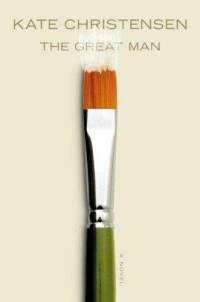
When we spoke a few years ago about the wrongheaded critical response to your first novel, which ended up being lumped with Bridget Jones despite having more in common with Lucky Jim, you said, “I felt a bit like an underdog/loser with a thwarted ego and an axe to grind in one of my own novels, and in that sense it was ironic, fitting, and really, the best thing that could have happened to me. Sure, it pissed me off at first, because few things are more infuriating than being underestimated, but it also lit a fire under my ass, so to speak, and taught me a few valuable Zennish lessons about writing: Let It Go (you can’t control what people make of your work); Keep Moving Forward Like a Shark (all you can do is write more books); and Ride the Ocean Tides and Stay Your Course (your internal compass, not a glowing or scathing review, is the one authority to be heeded and obeyed). If by some stroke of bizarre and undeserved fortune my first novel had been hailed as genius and won prizes and I’d floated off in a filmy golden bubble of critical blowjobs and huge advances,” you said, “that would not have been in any way as good for me as a writer as being written off as disposable fluff. Honestly.”
Not long after we had that conversation, you won the PEN/Faulkner. How did that feel? Knowing you, I’m sure you didn’t float off in a filmy golden bubble, but did you feel mostly excited and inspired, or more pressured and anxious, or…?
It made me want to work even harder, write even better. I felt both anxious and inspired, in about equal parts. Because it was my fourth novel, and not my first, I was able to keep things pretty well in perspective. I felt very lucky. It was a great thing to have happen. But it couldn’t affect how or what I write; that all happens underground, and this was a public thing. The two exist in completely different realms.
I for one still feel your work is underappreciated. Plenty of female writers, from Muriel Spark to Marilynne Robinson, write about men well, but I’ve had trouble thinking of many who do it so flintily, and with such humor and brio, in first-person. Patricia Highsmith and Iris Murdoch, maybe? Who would you add?
First of all, Housekeeping is one of my all-time favorite novels. I haven’t read much Highsmith or Murdoch, but I feel I ought to. I’ve always loved and admired Dawn Powell, MFK Fisher, and most of the mid-20th century female British novelists — Penelope Fitzgerald, Margaret Drabble, Mary Wesley, and Muriel Spark, to name just a few. Their tough-minded, clear, ironic, passionate, subtle, wide-awake voices are some of my greatest inspirations. They all understand people, men and women both, in ways I find true and thrilling.
For Murdoch, I recommend starting with The Sea, The Sea or The Black Prince; that was the advice a friend gave me, and he was so right. Under the Net, her first novel, is a great romp, though, and maybe more up your alley. I read that one after Randa Jarrar posted that she was consumed with jealousy to find anyone had written a first novel that good. (In fact, she discovered, it was Murdoch’s fifth novel, just her first that was published.) I love Spark, Drabble, Powell and Fisher. Spark especially; I idolize her. Clearly I need to get to Wesley and Fitzgerald…
Why did you write from a poet’s perspective this time around?
Poets make reliable narrators. They distill, refine, make magically potent their perceptions, experiences, and observations, rather than codifying according to moralistic preconceptions or warping to conform to dogma — they take life and make clear, true liquor out of it. A poet is an everyman and a fool, a member of an effete and obscure subset of our species who writes for himself and others like him.
I wanted to be a poet, but I lack the sensibility; I’m too social and too long-winded. Choosing a poet for a narrator — a struggling, down-on-his-luck poet who has run aground on the limitations of his lifelong adherence to form, since no form can contain his poetics anymore — was self-indulgent wish-fulfillment on the one hand, since it was sheer pleasure to inhabit his psyche and voice, and on the other, a necessary narrative strategy.
Who are some of the poets you admire most?
Elizabeth Bishop, Wallace Stevens, Francois Villon, Emily Dickinson… I’m all over the map in terms of poetry. I used to read it a lot. Every day. I kept poetry collections by the bathtub and sat dreaming in the bath over poetry, letting the language wash my brain and leave behind its residue. The older I get, the less poetry I read.
The novelist at midlife would seem, if I can be seen as an average example, to be focused, pragmatic, antisocial, a homebody kind of creature. I was wild when I was younger, my brain roamed all over the place, I drank too much and loved loud music and walked the streets of New York in a manic state of wonderment. I read so much poetry, craved it, wallowed in it.
I feel as if my first decades were spent ingesting everything I could greedily swallow of the world and of life. These midlife years, I feel like a stomach, digesting, recollecting, understanding in a ruminative way (what does this say about my end years, no pun intended, if I was a mouth first and now am a digestive system? Oh dear). Reading poetry augmented and fed my adventurous sense of living as fully as possible. I have amassed a lot of experience to mull over in tranquility. That is my greatest pleasure now.
One constant in your novels has been New York. You’ve portrayed the city so vividly and lovingly, it feels endemic to your storytelling. Do you think that’s changing now that you’re living in New Hampshire?
I don’t know yet; it’s too early to tell. For 20 years, I felt married to New York, and now we’re getting a divorce; during those two decades, New York was my place-muse, and now I’m a little tired of it, but not entirely over it. My next one, Gin on the Lanai, which I’m about to start, will be about a New York-based food writer who goes to Kauai to research Hawaiian cuisine; the book is set elsewhere, but the sensibility will very probably be profoundly New York-y. This might be the direction I’m headed in; I’m curious to find out.
Can’t wait! See you back here in a couple of years.
Maud Newton is a writer and critic best known for her blog, where she has written about books since 2002.
Medicating The Kids
The second part of that New York Review of Books piece on our prescription-happy mental health industry is available here. This installment is actually more alarming than the previous one.
David Bowie, In Order
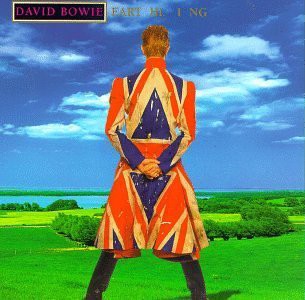
23. Earthling
22. Tonight
21. Never Let Me Down
20. Hours…
19. Black Tie White Noise
18. Reality
17. David Bowie
16. Pin Ups
15. Heathen
14. Outside
13. David Bowie/Space Oddity
12. Let’s Dance
11. Young Americans
10. Aladdin Sane
9. Diamond Dogs
8. The Man Who Sold The World
7. Hunky Dory
6. Station to Station
5. Scary Monsters (and Super Creeps)
4. The Rise and Fall of Ziggy Stardust and the Spiders from Mars
3. “Heroes”
2. Lodger
1. Low
Everything Is Pop Up This And Pop Up That These Days
From Awl pal Bex Schwartz, it’s the Pop Up Chapel: “On Saturday, July 30th, the first weekend after same-sex marriage becomes legal, we will host New York City’s largest pop-up chapel at the beautiful Bethesda Fountain in Central Park (or a designated space, if interest outpaces capacity.) We provide the wedding! And the photographer! And the officiant! And witnesses! And cupcakes! And everything you’ve always dreamed of! A free and legal wedding, for anyone who wants to get married.”
Eating Out At Four Of TV's Best-Known Restaurants
by Josh Kurp
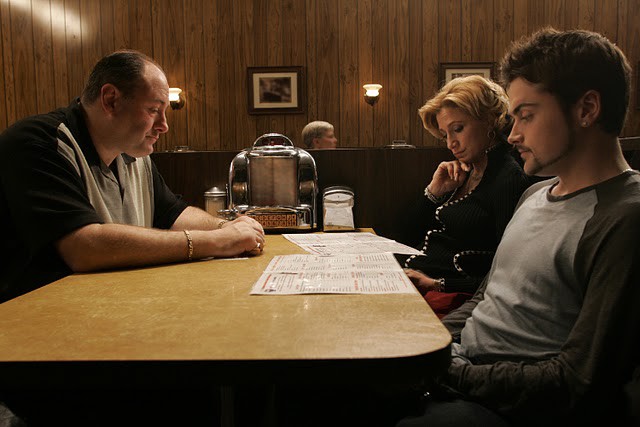
Holsten’s in Bloomfield, New Jersey (“The Sopranos”)
In the final episode of “The Sopranos,” the family meets up at Holsten’s in Bloomfield, New Jersey, to eat (among other things) onion rings that are, according to Tony Soprano, “the best in da state.” Last year, for my birthday and shortly after my girlfriend Nadia and I finished watching the show — a time during which we lived and breathed all things Johnny Cakes and Ralphie — we rented a car and drove from Brooklyn to Jersey, with the simple goal of sliding into the same booth that Tony, Carmela and A.J. once shared.
Holsten’s is a charming, old-fashioned diner that, having homemade ice cream and candy, bills itself as a “confectionary.” On “The Sopranos,” it looks dark and peeling, like the back office of the Bada Bing, minus the posters of naked ladies; but seen in person, it’s well lit, wood paneled, and family friendly, somewhere old people and Boy Scouts alike can enjoy a steamed ham. The sodas are homemade and the milk shakes are gigantic and authentic. It’s like the 1950s never ended, down to the hideous storefront and menu fonts and waitresses that call you “hon.” We both got burgers (diner burgers, like most things in life, are usually better in imagination than in reality, and the ones at Holsten’s were no exception) with a side order of onion rings, presented to us in a small brown plastic bowl. The rings were good, but nothing special; they could have been a little more burnt, and besides, I once had a perfectly good meal of onion rings at the Burger King in the 11th most Jersey’ish rest stop on the Turnpike.
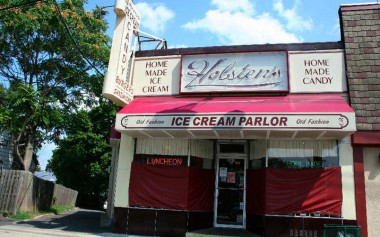
We were seated in a booth against the wall. Above us were photos of David Chase and the Sopranos crew filming on location back in 2006, right next to The Booth, the one where Tony may or may not have met his fate from Members Only Jacket. Midway through our meal, the occupants of The Booth left, leaving it wide open for Nadia and me. We called the waitress over, and given that we had done nothing but gawk like tourists in Times Square since we walked in, we barely had to finish our request about switching booths before she said, “Go right ahead.”
The final episode of “The Sopranos” aired in 2007, and I can imagine that, in the post-finale world, hundreds, if not thousands, of fans of the show came to Holsten’s, some looking for clues, others wondering if Tony was full of shit with his onion-ring proclamation. Three years later, Nadia and I seemed to be the only non-regulars, or at least the only two who were awed that James Gandolfini’s ass had once touched this exact seat. (It should be noted that I let Nadia sit on the Tony side of The Booth, while I rested where Carmela and A.J. resided — if only Meadow had parked that car quicker).
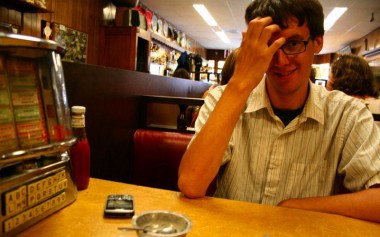
The onion rings not being up to snuff wasn’t the most disappointing thing about Holsten’s, however: They didn’t have “Don’t Stop Believin’” on the table jukebox! And the jukebox doesn’t even work! I flipped through the thing three times, hoping that this wasn’t the one jukebox in the country that doesn’t have the Journey classic, but alas, it was, and I felt oddly betrayed, even more so when I went into the bathroom and realized that there was really no good hiding spot for Members Only Jacket to retrieve a gun. (This is assuming, of course, that a), he killed Tony, which he obviously did; and b) he didn’t already have the gun on him, which I don’t think he did because he would have popped him on the way to the bathroom and the gun-in-the-bathroom staging is clearly a nod to The Godfather, the single biggest influence on “The Sopranos”).
On the plus side, Holsten’s ice cream is fantastic, and, on the way out, I picked up a promotional postcard for Donald and Allison, “Sopranos look-alikes” and Tony and Carmela’s doubles on the show, to come “liven up your next party, promotion, corporate event, or fundraiser.” Outside of Roseanne and Dan Conner, Tony and Carmela would be the ideal choice if you ever needed a TV couple to come into your office and start screaming at one another, especially if you could find a Gloria impressionist somewhere out there, too.
Twede’s Café in North Bend, Washington (“Twin Peaks”)
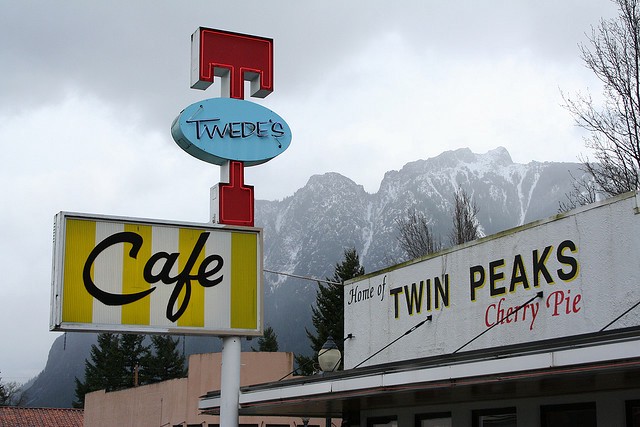
My father and stepmother moved to Seattle from Houston in 2008, a location change that made me happy; who wants to visit Texas when they can spend time in the place known for its greenery, grunge and G., Kenny? When Nadia and I visited in March 2009, we went to the Space Needle (obviously, and it’s really disappointing, like visiting Plymouth Rock), the house where Kurt Cobain shot himself (don’t judge), and then the town of Snoqualmie with its famous waterfalls and the lodge which was used as the exterior shot for the Great Northern Hotel in David Lynch’s “Twin Peaks.”
After pretending we were Laura Palmer for a bit and then getting caught in the rain and hail, we drove to Twede’s Café, which markets itself as the Twin Peaks Diner. Roy Thompson built the building in 1941 (and it’s been owned by Thompson’s family ever since), and from the outside, it looks 80 years old. Inside, though, it feels inauthentic; in 2000, a fire damaged much of the building and the interior had to be re-done, and now, instead of replicating the interior, there are dirty Tweety Birds hung all over the walls and ceiling — it looks the way someone trying to replicate nostalgia would decorate their establishment. In other words, like a Johnny Rockets. But you can still see tons of “Twin Peaks” memorabilia, including trading cards, placemats, bumper stickers and pictures from when the cast and crew shot the pilot there in 1990, where it was called the Double R Diner. (For the remainder of the show’s run, any scenes set in the diner were filmed on a soundstage in Los Angeles.)
The real diner has a selection of 50 burgers, which are listed from A-Z, meaning you could get everything from the Backfire (pepper jack cheese, hot peppers and hot mayo) to Whoa Baby (a pound of beef). There were no A or Z choices, but a Peanut Butter & Jelly Burger was available. I asked a waitress if anyone had ever ordered this. No one had.
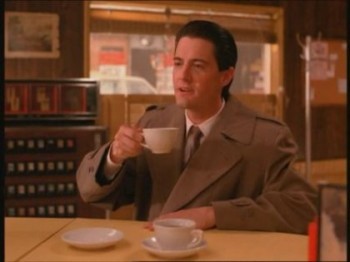
I ordered the Philly (sautéed onions and peppers, Monterey Jack, lettuce, tomato and mayo), Nadia got the Santa Fe (pepper jack, bacon, guacamole, peppers, onion, lettuce, tomato), and we both asked for a side order of fries. The portions were huge, with the fries spilling over the side of the plate (as it should be at every diner), but the burgers were overdone, which I guess is better than under-, but still. The fries were plentiful and crunchy and delicious.
We ended our meal the same way any self-respecting TV fan would have: with a slice of cherry pie and a damn fine cup of coffee. But like the onion rings at Holsten’s, the coffee was, at least according to Nadia, normal — nothing special about it. As for the pie, even with a sugar-encrusted top, it wasn’t particularly memorable — not even Norma Jennings could save it from mediocrity.
As a fan of “Twin Peaks,” it was fun going to Twede’s Café, even if the place barely resembled what it looked like on the show. As a fan of food however, well, I wouldn’t go as far as a Yelp reviewer who quipped that he now has a “pretty good idea what killed Laura Palmer,” but even for a diner, it was underwhelming. Twede’s seems confused about to whom its marketing — “Twin Peaks” fans or truckers or elderly women — and it shows. Maybe they should be looking into the “The Killing” fanbase? Instead of Tweety Birds, they could have red herrings pinned to the walls.
Tom’s Restaurant in New York, NY (“Seinfeld”)
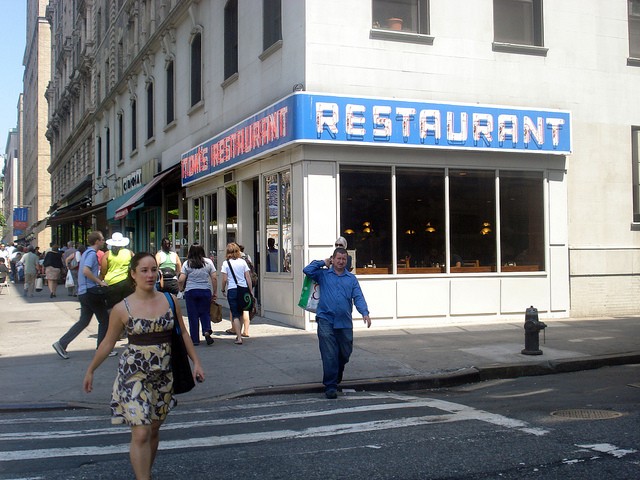
So far the theme of these pilgrimages has been unexpected disappointment, so let’s switch things up: I knew I wasn’t going to like Tom’s Restaurant before I even got there.
I’ve lived in New York long enough now to have heard word-of-mouth reviews of nearly every tourist trap in the five boroughs, particularly Manhattan. And as a fan of “Seinfeld,” my ears always perked up at mentions of Tom’s Restaurant, which is located on the corner of 112th Street and Broadway, near Columbia University. The diner first became famous as the setting of Suzanne Vega’s mega-hit “Tom’s Diner” (which I listened to for the first time in years while writing this piece, and it’s still just as memorably awful, but in a catchy sort of way, as I remember it being, especially the “I Dream of Jeannie” beginning), and then mega-famous as the fictional setting of Monk’s Café, where Jerry, George, Elaine, and Kramer would eat on “Seinfeld.”
Like Twede’s Café, only the exterior of the building was used on the show, and if you pay careful attention, you’ll notice on “Seinfeld” that the “Tom’s” of the Tom’s Restaurant was almost always cut off, so that they wouldn’t have to pay for the rights. The interior looks nothing like it does on the show (the waitresses aren’t as busty, either) and the only “Seinfeld”-related piece of memorabilia in the diner is a poster of The Kramer. Of course, that doesn’t stop them from having an online store, where you can purchase a Tom’s Restaurant postcard, to “send [to] a loved one or a Seinfeld fan,” for only .99 cents.
Even though I did my best to keep an open mind, my expectations turned out to be accurate: the food was pretty bad. Although the prices are decent (Cheeseburger Deluxe for only $7.15) and the hours college student-friendly (Sunday-Wednesday, 6 a.m.-1:30 a.m.; Thursday-Saturday, 6 a.m.-5:30 a.m.), Tom’s seems to be coasting, and doing steady business, based on past reputation alone. Maybe I’m expecting too much out of a simple diner, but I mean, how tough is it to make a good burger, one that isn’t burnt to a crisp or tastes like grease? The service was terrible and you can’t even order a Big Salad, which I would have thought was a given. The Large Green Salad just doesn’t have the same ring to it. If you’re going to be a pop culture landmark, at least go all the way.
Jimbo’s Place in Virginia Key, Florida (“Dexter”)
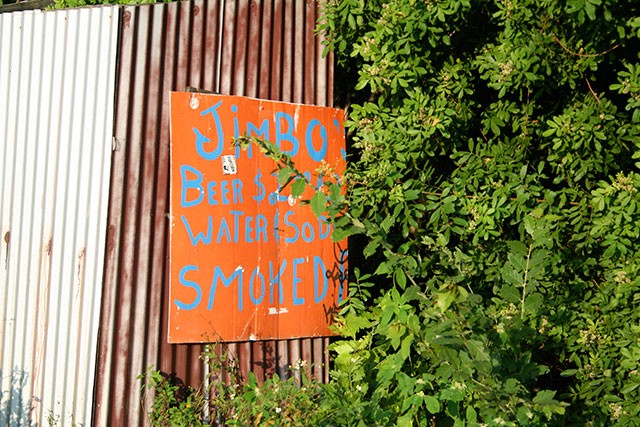
My grandparents live in Boynton Beach, because they’re grandparents and that’s just where grandparents go. Their apartment complex is an hour’s drive from Miami, a city I had no particular interest in visiting until I started watching “Dexter,” about a serial killer who kills other serial killers but works for Miami Metro Police. Of my many man-crushes, Michael C. Hall tops them all, and although “Dexter” is a severely flawed show that treats its viewers like they’re idiots who crave exposition, I can’t help myself from loving it, mostly because of MCH.
(The fact that my reason for loving “Dexter” is because I have a dude crush on Hall says everything about the show — or maybe about me…)
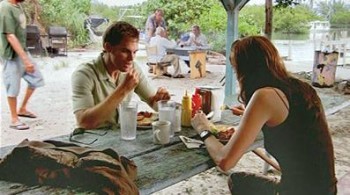
Most of “ Dexter” is filmed on West Coast, so Nadia and I were pretty limited with on-location hot spots to visit in Florida. But there are two notable attractions: Dexter’s apartment (which we went to, then promptly ran away from in fear due to all the signs proclaiming “Cops Will Be Here in Five Minutes If You’re a Dexter-Loving Trespasser”) and Jimbo’s Place, which is inexplicably one of Florida’s most-filmed locations.
You know how people tell a cab driver, “Take me to somewhere great off the grid”? Jimbo’s feels like the sort of place where you might get dropped off. It isn’t a bar so much as it’s a place where people hang out and drink, and it looks like a displaced, brightly colored trailer park after a storm came through — and that only adds its to charm. It’s reminiscent of the pre-Disney Florida (or at least the way someone who’s lived in the Northeast his entire life envisions the Sunshine State was before Goofy and Mickey invaded).

After stretching a 20-minute drive from Miami into a one-hour journey, as we kept taking wrong turns trying to find the place (I recommend watching the Quicktime video on the website before trying to find it yourself), we drove up and saw a dilapidated shack, outhouses, smoked fish stand, wooden fences painted in a variety of colors, an old school bus painted with graffiti, a covered bocce ball court, cats, more cats (there were a lot of cats, some 40 in all), and a variety of knick-knack-type stuff, everything from old fishing nets to cigar butts, all seemingly arranged by the Little Rascals.
A very important scene in “Dexter” happened here: after the death of his wife, Rita, Dexter goes for a boat ride to think things over, and ends up at Jimbo’s. Dexter comes across a redneck who calls him a word you shouldn’t say to anyone, let alone a serial killer in his mourning period, and after our hero says he’s had a bad week and that his wife just died, the redneck says that Rita could suck his dick. This comment puts Dexter over the top and, in a rage, he stabs the redneck, killing him immediately. Dexter’s father, Harry, who’s long since passed away but still provides his son with advice on how to deal with his Dark Passenger, says that this is the first human thing he’s ever seen Dexter do.
Jimbo’s would be a great place to kill someone, and I mean that in the most complimentary way. It’s remote, located right on the water and mere steps away from the unknown wildlife.
I tried to put this thought out of my mind when Nadia and I walked up to the sign announcing “Beer $2” and away from it with two Miller Lites in hand. Not sure where to go first, we instead just stood around in the middle of everything. One of the patrons came up and introduced himself. He was a regular of the establishment and began to tell us about all the different photo shoots, movies (Ace Ventura, Porky’s II) and TV shows (“Burn Notice,””Flipper,” “Miami Vice”) that had been shot and filmed there over the years. To emphasize his point, he pointed over to the old school bus where a professional photographer was taking pictures of a soon-to-be husband and wife in their wedding clothes. They were not holding $2 Miller Lite cans.
Using my BlackBerry (yes, there was cell service, and yes, I’m a terrible person for checking my BlackBerry all the time), I found stills from the episode, so we could know exactly where Dexter stood (remember everything I said about Hall earlier? Multiply that by ten for Nadia). Once satisfied that we were within a few feet of where a fake serial killer once killed his victim, we drifted over to a sofa (surprisingly rigid) next to the shore, plopped down and, beers in hand, watched the water gently flow, not unlike the way the blood came out of that poor, stupid redneck.
Jimbo’s Place was a bitch to find, but it was all worth it for that moment.
Josh Kurp really wishes Uncle Moe’s Family Feedbag was a real restaurant.
Photos of Holsten’s, Twede’s and Jimbo’s Place by Nadia Chaudhury, used with permission; photo of Tom’s Restaurant by n8kowald from Flickr.
Magical Recording of Beyoncé Doing Prince
And here is Beyoncé covering Prince’s “The Beautiful Ones” (and Kings of Leon’s “Sex on Fire” (whatever)) this weekend. She’s been doing this on tour for a bit (and covering Prince for a couple of years, and of course she performed “Purple Rain” with him in 2004) but this is the first really stellar recording of this; I would describe this as LIFE-CHANGING. Stop work, put your headphones on, etc. I do wish she hadn’t switched the genders in the lyrics though. (via, previously)
The Great New York City Children's Day Fireworks Scandal
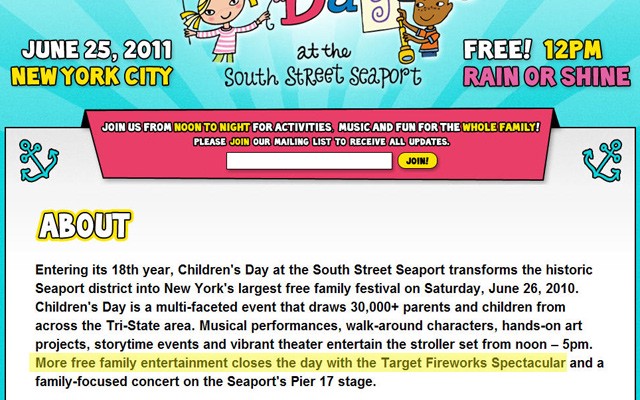
Why, you may have asked, do we keep telling you that there will be fireworks to see each weekend, and then, when you venture down to the river or up to the rooftop, you find no fireworks at all?
Malfeasance. Potentially mismanagement. Possibly even great evil. Perhaps even a deep-seated hatred of children?
According to (the recently dismembered) Time Out, Saturday, June 18th was to be “Children’s Day NYC
, at the South Street Seaport. (Not to be confused with Missing Children’s Day, which is held on May 25th, and is totally different.) “More free family entertainment closes the day with the Target Fireworks Spectacular,” they and many other publications claimed.
Number of fireworks on June 18th? ZERO.
That is because this date was incorrectly listed, in multiple venues. In fact, “Children’s Day NYC” takes place on June 25th, “rain or shine,” according to the organizer’s site and Facebook page. (The event is conducted by Dima Productions, who also produce the River to River festival and the New York Comedy Festival.)
What’s worse? “When someone commented on the Children’s Day Facebook page that they brought their kids to the Seaport on the 18th only to find no Children’s Day, they were told that the mixup was due to the fact that some publications didn’t do proper fact checking,” writes one concerned local. And then this Facebook exchange was nuked entirely.
Well, mistakes happen. But then!
Stunningly, at some point on the 25th, the sentence about fireworks was scrubbed from the event’s website. Above, the Google cache of the site reveals the truth. Oh yes, there were to be fireworks. But the fireworks were disappeared. (“On Saturday,” recalls a concerned neighbor and friend to children, “someone asked about the location of the fireworks sometime around 6, and was matter-of-factly informed that there wouldn’t be any (this exchange has also since been scrubbed from their Facebook wall). No indication of a cancellation, implying instead there never had been any planned.”)
Who are these monsters who would do this? And to the children, no less! Lesson learned: don’t ever believe there will be fireworks until you actually see things being shot from a barge. Maybe there’ll be some on the 4th of July! And maybe not.
